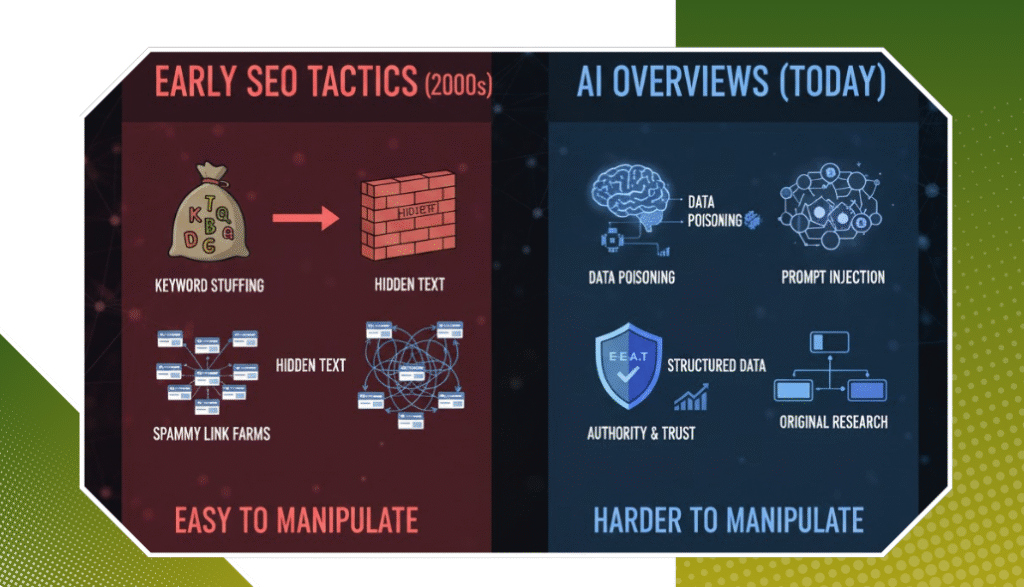The digital environment changed dramatically. Search engines use advanced technologies, like AI, voice recognition as well as machine learning, to give tailored results. Because of these changes, a business requires a modern approach to SEO strategies, such as AI-driven search algorithms, enhanced user experience requirements, privacy-focused data handling and multi-platform content optimisation.
Your business must adjust to these changed SEO trends. Though companies that accept these changes obtain a competitive benefit, those who disregard them risk lagging. The insights below disclose the essential SEO trends shaping Canadian business achievement in 2025.
AI-Enhanced Search
Artificial intelligence technologies, like ChatGPT besides Gemini, altered user interactions with search engines. Those platforms permit natural queries written like a conversation, so businesses must change the content strategies.
Users pose hard questions then hope for thorough, right answers. Your content must answer certain questions right away. It also needs to give inclusive details in small amounts plus add context plus data which supports it—structure content like questions with answers.
To match up with artificial intelligence search patterns, produce content that speaks to user intention. Use human words in headings and subheadings. Divide complicated subjects into digestible parts. In addition incorporate real data and numbers to defend claims.
Because AI tools examine content quality, relevance, and originality, your content shows expertise, even with reading ease, also interest. It should center around creating value-rich resources that both AI systems and human readers know plus are grateful for.
Google’s search algorithms place importance on websites that give superb user experience. Core Web Vitals directly affect search rank through three important scores. Largest Contentful Paint measures loading speed – try for under 2.5 seconds. First Input Delay watches interactivity – target less than 100 milliseconds. Cumulative Layout Shift checks visual stability – keep under 0.1.
For improving site performance, compress images besides employ next-generation formats. Use browser caching. Trim down Javascript plus CSS files. Pick a trustworthy hosting provider. Put into service mobile responsiveness.
In the end a well-optimised website makes a good user experience. This leads to expanded involvement, lowered bounce amounts and heightened conversion percentages. Your site’s technical performance sends strong signals to search engines about your content’s value and relevance.
High-Quality Content
Technical execution on your site communicates the worth and suitability of your content to search engines. Quality content became more important. Google’s algorithms separate common AI-created content from real, useful material. Your content plans must emphasize depth and newness to keep good search positions next year.
Generating quality content needs information supported by research and reliable sources. It needs individual views besides expert opinions plus writing that is easy to read, directly addresses specific user issues and completely covers topics. Regular content reviews and revisions are important too.
To raise your content’s value, do user surveys to learn their problems. After this examine search intention data, add actual examples and situation analyses and input unique data or personal research. You should incorporate expert interviews also industry views as well.
You must create content that meets your audience’s objective. Generic, thin content will struggle to rank as Google’s algorithms become more sophisticated at identifying valuable resources that help users solve problems or find answers.
The Importance of Local SEO
Local SEO is crucial for Canadian service-oriented businesses that want to reach their local market. Since you have a physical presence in local communities, it’s essential to have a strong online visibility strategy.
Key Elements of Local SEO
Here are the essential elements you need to focus on for effective local SEO:
- Ensure consistent NAP (Name, Address, Phone) information across all platforms
- Use location-specific keywords in your website content
- Manage customer reviews and ratings actively
- Use local business schema markup on your website
Optimising Your Google Business Profile
Your Google Business Profile is just like your online storefront. To make the most of it, follow these tips:
- Upload high-quality photos of your business
- Share regular updates about your services and promotions
- Respond promptly to customer reviews
- Provide accurate information about your business hours and service areas
Engaging with Your Local Community
Forming relationships with your local community can also improve your SEO presence. Here are some ways to get involved:
- Attend local business events and link with other entrepreneurs
- Collaborate with neighbouring businesses for cross-promotions
- Create content that is related to your location and share it online
- Support community initiatives and projects that align with your brand values
Implementing these strategies will allow you to connect more deeply with your target audience and increase your ranking rates in search results for specific geographic areas.
Multimodal Search Optimisation
Search engines now process information through multiple formats, creating a rich tapestry of search possibilities. You need to adapt your content strategy to accommodate these diverse search methods:
Text-Based Content
- Create descriptive meta titles and descriptions
- Use relevant headers and subheaders (H1-H6)
- Include structured data markup
Visual Content Optimisation
- Add descriptive alt text to images
- Use relevant file names for media
- Compress images without quality loss
Video Search Enhancement
- Create detailed video descriptions
- Add closed captions and transcripts
- Use engaging thumbnails
Implementing these multimodal optimisation techniques can give Canadian businesses a competitive advantage. Your content must be discoverable across all search formats to capture the broadest possible audience. Users switch between search methods based on context and convenience, and your SEO strategy must reflect this behaviour.
Ethical Content Creation
The E-A-T framework extends beyond traditional metrics to embrace ethical content creation practices. Google’s algorithms reward content that demonstrates:
- Ethical Sourcing: Proper attribution of research, data, and quotes
- Inclusive Language: Content that respects diversity and avoids discriminatory terms
- Factual Accuracy: Regular fact-checking and updates to maintain information relevance
Building trust requires transparent disclosure of the following:
- Affiliate relationships
- Sponsored content
- Data collection practices
- Content update timestamps
Your content strategy should prioritise:
- A clear distinction between facts and opinions
- A balanced presentation of controversial topics
- Accessible content for users with disabilities
- Regular content audits for accuracy
Canadian businesses implementing ethical SEO practices see improved user trust and higher engagement rates. A study by the Canadian Marketing Association shows that 78% of consumers prefer brands with strong ethical standards in their digital presence.
Voice Search Optimisation
Voice-activated devices have changed how people search online. 40% of Canadian households now use smart speakers for everyday tasks, requiring a new approach to SEO strategies.
How to Optimise for Voice Search
To improve your content for voice search, consider the following:
- Structure your content around question-based queries
- Use conversational language that matches natural speech patterns
- Target long-tail keywords specific to voice commands
- Create FAQ sections addressing common voice queries
Understanding Voice Search Patterns
Voice searches usually follow specific patterns. Here are some examples:
- Location-based: “Where’s the nearest coffee shop?”
- How-to queries: “How do I fix a leaky faucet?”
- Product information: “What’s the price of an iPhone 15?”
Your content should align with these patterns using natural language and concise answers. Additionally, consider creating dedicated landing pages for voice-specific queries and implementing schema markup to improve search engine understanding of your content.
Data Privacy Considerations
Data privacy regulations shape the future of SEO strategies in Canada. The (PIPEDA) sets strict data collection and usage guidelines, impacting how businesses track user behaviour and implement SEO tactics.
Key Privacy Requirements for Canadian Businesses:
- Implementation of cookie consent mechanisms
- Transparent data collection policies
- Limited storage of personal information
- Regular privacy impact assessments
The shift toward anonymised data usage creates new challenges for SEO practitioners. You’ll need to:
- Rely on aggregated data insights
- Use privacy-preserving analytics tools
- Focus on first-party data collection
- Adapt to cookieless tracking alternatives
Google’s Privacy Sandbox initiative introduces new APIs for targeted advertising without third-party cookies. This change pushes businesses to develop privacy-compliant SEO strategies while maintaining effective user targeting and measurement capabilities.
Engagement through Interactive Content
Interactive content shifts passive readers into active participants, creating meaningful connections with your brand. You’ll see significant improvements in user engagement metrics through:
- Quizzes and Assessments: Industry-specific knowledge checks, personalised product recommendations, self-evaluation tools
- Interactive Infographics: Clickable data visualisations, animated statistics, explorable timelines
- Calculators and Tools: ROI estimators, cost comparison tools, industry-specific calculators
These interactive elements provide valuable user behaviour data, helping refine your SEO strategy. Canadian businesses implementing interactive content see an average 40% increase in time spent on the page and a 25% boost in conversion rates.
Your interactive content creates a two-way conversation with users, generating rich feedback data through:
- User preferences
- Pain points
- Decision-making patterns
- Content engagement levels
Conclusion
The future of SEO in Canada requires flexibility and careful planning. These 2025 SEO trends are essential changes in digital marketing that Canadian businesses need to adapt to stay competitive. Your success relies on being proactive about these changing trends while maintaining genuine connections with your audience.
Are you ready to update your SEO strategy for 2025? SEO team specialising in implementing cutting-edge SEO solutions for Canadian businesses can assist you in understanding these new trends and creating a strong online presence that delivers results. Contact Us at Rankingeek Marketing Agency today to develop a future-proof SEO strategy tailored to your business needs.




